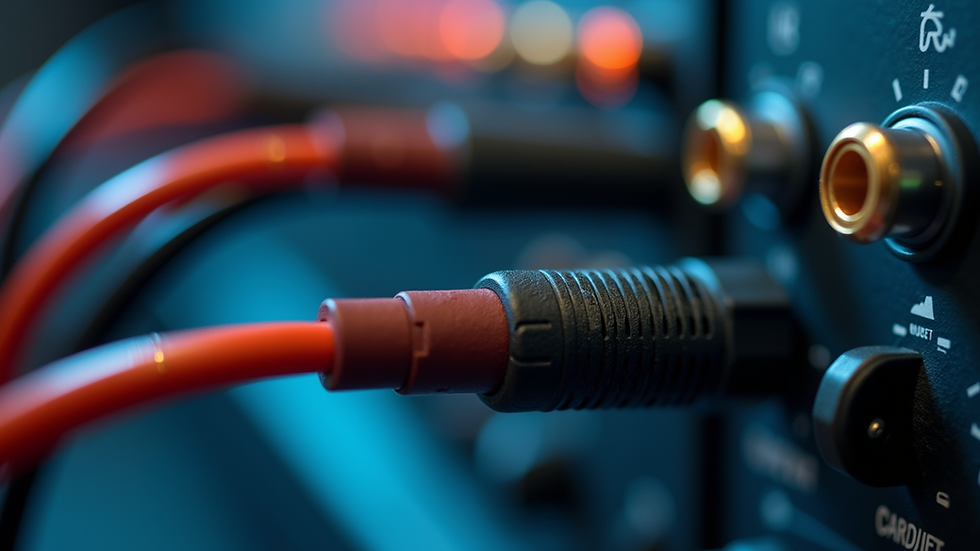The Science Behind High-Fidelity Sound Systems
- 20210827
- Jul 7
- 4 min read
In today's world, sound quality can make or break our experience with music, movies. It’s not just about hearing the notes; it's about immersing yourself into the performance. That's where high-fidelity sound systems come into play. These systems aim to replicate sound as accurately as possible. But have you ever wondered what goes into achieving such high-quality sound? Let’s dive into the science behind these remarkable systems.
Understanding High-Fidelity Sound
High-fidelity sound refers to audio reproduction that accurately represents the original recording as closely as possible. This means less distortion, minimal noise, and a broader frequency response. The goal is to create an experience that mimics a live performance.
The Importance of DESIGN
Design is a critical component of high-fidelity sound. It creates a pure sound system can reproduce different frequencies, from deep bass to high symbols . A quality high-fidelity sound system usually has a frequency response range between 20 Hz to 20 kHz. This range covers the full spectrum of human hearing design goes way beyond this but more is always good . Your ears count not numbers
What Does It Mean for You?
A system that accurately reproduces all frequencies ensures that you hear the nuances in music. For example, you can catch the subtle details in a violin's pitch or the rhythmic pulse of a bass guitar. Systems that lack this sort of range can often lead to a "muddy" or "tinny" sound, which detracts from the listening experience.

The Components of a High-Fidelity Sound System
To achieve high-fidelity sound, all components interact harmoniously. Let’s break down some of the vital elements:
Speakers
Speakers are perhaps the most obvious components of a sound system but interestingly the least important .High-fidelity speakers are designed to reproduce sound waves accurately. They consist of drivers that produce different frequencies. High-quality drivers use sophisticated materials to ensure clarity and precision but what you get out is directly related to what you put in . Speakers are the last part of the chain .
Amplifiers
Amplifiers are the master of every single speaker . A quality amplifier should provide a clean, distortion-free output and drive the speaker's by pulling it in and pushing it out as fast as it requires . A high-fidelity amplifier will enhance the performance of your speakers and is crucial for achieving high-fidelity sound. Distortion is 99% amplification quality
Source Components
The source component refers to the device that plays your audio—think of your turntable, CD player, or digital music player. A high-fidelity source seeks to deliver audio that is as close to the original recording as possible.
Cables and Connections
The quality of cables and connections should not be overlooked. High-quality cables minimize signal loss and interference, ensuring the best audio performance. Poor-quality cables can introduce unwanted noise into the system and frankly just make your system sound bad

What is a High-Fidelity Amplifier?
A high-fidelity amplifier like all UK Made and Designed ONIX AUDIO amplifiers are designed to amplify audio signals with near zero distortion. Unlike standard amplifiers, which might color the sound, high-fidelity amplifiers strive to provide a transparent and pure sound output. This means the audio you hear is as close to what was recorded as possible. The better the amp the better the sound .
Why Choose a High-Fidelity Amplifier?
Investing in a high-fidelity amplifier benefits your entire sound system. With superior amplification, you're less likely to experience clipping, distortion, or other unwanted artifacts. An amplifier that performs well can make even an average set of speakers sound exceptional.
The Role of Digital Audio Processing
In recent years, digital audio processing has become an essential element of high-fidelity systems. Digital signal processors (DSPs) analyse and manipulate audio signals to enhance sound quality.
What Does DSP Do?
DSP can help correct issues like room acoustics that may detrimentally affect sound quality. By adjusting various parameters, DSPs can optimize the audio for the specific environment you’re in. This means you can get the best experience, regardless of where your sound system is set up.
Importance of Room Acoustics
Even the best sound systems can fall short in poorly designed spaces. Room acoustics—the way sound behaves in an environment—can significantly influence audio quality. Here are a few considerations:
Sound Reflection and Absorption
Different surfaces reflect or absorb sound differently. For instance, hard surfaces like tile or glass reflect sound waves, while soft materials like carpets or curtains absorb them. To optimize your high-fidelity sound system, consider acoustic treatment solutions such as wall panels, bass traps, or diffusers.
Speaker Placement
Where you place your speakers can also impact sound quality. Ideally, speakers should be positioned to create an equilateral triangle with your listening position. This arrangement helps achieve the best soundstage and imaging.

Final Tips for Achieving High-Fidelity Sound
Achieving high-fidelity sound requires attention to detail. Here are some actionable steps to up your sound game:
Invest in Quality Components: Always opt for reputable brands known for their high-fidelity reputation when purchasing speakers, or cables.
Optimize Sources: Use high-quality digital files or analogue sources. The better the source, the better the entire setup will perform.
Choose the best value amp. Finding the perfect amplifier can make a world of difference to your system.
Consider Professional Help: If you're unsure about room acoustics or overall setup, consider consulting with an audio professional.
By understanding the science behind high-fidelity sound systems and diligently applying these methods, you can transform your listening experience into something truly extraordinary.


